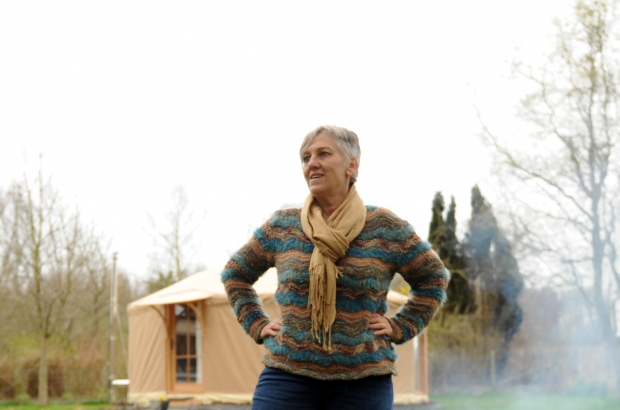- Daily & Weekly newsletters
- Buy & download The Bulletin
- Comment on our articles
Therapist offers shelter to expats in search of stability
A Mongolian yurt isn’t something you find every day in the Belgian countryside, but that’s precisely what you’ll see if you stroll through the Hoegaarden district of Rommersom in Flemish Brabant this summer.
When intercultural coach and therapist Linda Hoeben was looking to develop her practice, she wanted to include a place where expats could gather and talk about relocation. She decided that the yurt, a round tent traditionally used by the nomadic tribes of the Central Asian steppe, would make a perfect setting.
Hoeben, a graduate of the University of Leuven, has been providing professional relocation support to individuals and companies for over a decade. Originally from Limburg province, she is also a travelling spouse; for the last four years, she has been dividing her time between Latvia and Belgium because of her husband’s work as a diplomat.
“The most important thing I learned on my travels was to find stability in myself,” she says. “But also having the courage to engage in relationships. Finding that balance has been enriching – the balance between being self-sufficient and being open to relationships.”
Hoeben has sat for many hours with working expats, trailing spouses and their adolescent children, and says she feels privileged to have had the time to listen to them talk about their joys and worries.
Learning to leave
“As an expat, you have to learn how to leave things behind,” she says. “You detach from people and belongings, from places, habits and lifestyles.”
By losing these normal things, she explains, your life can never be the same. “This letting go of home is happening at the same time as embracing the new life, the new home, getting to meet new people, finding a house, a school, shops…”
Combining those two tasks is challenging, and it can be upsetting to have to let go of so many things that are familiar to us. But, says Hoeben, “when we have to question all of this, it opens up the opportunity for us to think about who we really are and what really matters.”
Coming home, too, can be a challenge, and Hoeben finds there are plenty of what she calls “repats” who are taken by surprise at the intensity of the reverse culture shock they experience on their return.
Then there’s a phenomenon she calls “connection tiredness”. “A number of experienced expats talked about the exhaustion of making new connections over and over again,” she says, “knowing that, in a couple of years, these, too, will be left behind and new ones will be required.”
Sometimes, she says, “we feel that we don’t have easy access to like-minded souls, which might not be true. It’s often simply a case of who is the first one to be brave enough to talk about what really matters.”
“Fast food for the starving”
Hoeben wanted to create an environment that would offer meaningful networking, going well beyond the tried and trusted “how long have you been here?” gambit. Hence the garden yurt, which she believes will fulfil a need in the expat lifestyle for old-fashioned communication.
“New technology makes it seemingly easier to stay in contact with people, and, at first sight this looks like an advantage,” she says. “But while it’s tempting to remain in contact with home via Skype, email or WhatsApp, it can sometimes prevent you integrating in your new home. It offers instant gratification, but it’s really a kind of fast food for the starving. I see more and more people hungry for real contact. When I look back, in all honesty, many of my clients didn’t need therapy or coaching. They needed simple human contact.”
The tent will be home to a range of training sessions and services including meaningful networking and intercultural communication, and covering everything from relocation stress management and understanding Belgian government structures to cooking with a local chef.
Hoeben admits her idea to have a yurt constructed outside her home initially drew some strange looks from friends and colleagues. “I remember the first time talking about it to people,” she says. “I saw their eyes widening – the way people do when they think you’re nuts but don’t want to say it.”
But she remained drawn to the sheltering shape of the yurt and the fact that, traditionally, it protects travellers from harsh winter conditions. It also houses a fire around which people can sit and tell stories.
“What I want to create is a place where when people walk in, they feel that it’s fine and safe to do whatever they need to do for their relocation to work. That may be learning new skills, or it may be just meeting people. That’s the heart of the project.”
She also thinks “taking on the adventure of building a yurt in my back garden” will inspire others to follow their hearts, “and make their relocation an exciting adventure, too.”














